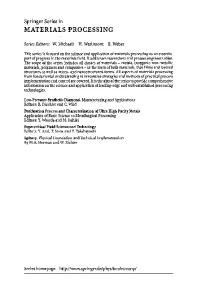Surfaces and Interfaces of Nanoscale Silicon Materials
- PDF / 13,434,281 Bytes
- 12 Pages / 612 x 792 pts (letter) Page_size
- 33 Downloads / 371 Views
Surfaces and Interfaces of Nanoscale Silicon Materials Sean R. Wagner and Pengpeng Zhang Department of Physics and Astronomy, Michigan State University, East Lansing, MI 488242320, U.S.A. Abstract Surfaces and interfaces play a critical role in determining properties and functions of nanomaterials, in many cases dominating bulk properties, owing to the large surface- and interface-area-to-volume ratio. Using Si nanomembranes, a well-controlled two-dimensional single-crystalline semiconductor, as a prototype system, we discuss how surfaces and interfaces influence electrical transport properties at the nanoscale. We show that electronic conduction in Si nanomembranes is not determined by bulk dopants but by the interplay of surface and interface electronic structures with the “bulk” band structure of the thin Si membrane. Additionally, we describe our recent experimental results on the control of highly ordered molecular structures on Si surfaces, which is of intense interest for the integration of ordered organic thin films in silicon-based electronics. This could also potentially lead to the rational design of Si nanostructures with controlled properties through regulation of the surface chemistry. Introduction In recent years, there has been a growing interest in applications of low dimensional nanoscale semiconductors such as two-dimensional nanomembranes, one-dimensional nanowires and nanotubes, and zero-dimensional quantum dots due to their unique transport and quantum confinement properties [1-3]. However, new challenges as well as opportunities emerge owing to the large surface- and interface-area-to-volume ratio of these nanostructures. For instance, the existence of surface states, dangling bonds, defects, charged impurities, etc. may lead to Fermi level pinning [4], doping of nanostructures [5, 6], trapping of mobile carriers [7, 8], charge redistribution, or charge scattering [9, 10]. On one hand, these effects can be utilized to tailor the properties of semiconducting nanostructures. On the other hand, for applications where surface effects are not desirable, it will be necessary to passivate the surface, in particular, the dangling bonds and defects [11] [12]. Consequently, one needs to be concerned about the interfacial electronic structures and charge transfer behavior between the passivation layer and the underlying material [13]. Taken together, it is critical to understand and further to utilize the influence of surfaces and interfaces on semiconducting nanostructures for their applications in nanoelectronics, molecular and biological sensors, and energy harvesting devices. In this paper, we use the Si nanomembrane, a single-crystalline two-dimensional nanostructure with a large surface-area-to-volume ratio, as a prototype system to discuss surface and interface effects on transport properties of semiconducting nanostructures. The Si nanomembrane is a novel and versatile class of nanostructures that exhibits a high degree of flexibility and conformational properties, offering a wide variety of appl
Data Loading...








